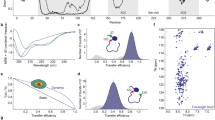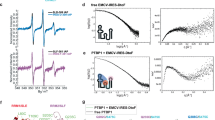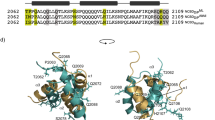Abstract
Members of the ets family of transcription factors share a conserved DNA-binding domain, the ets domain. By using multidimensional NMR, we have determined the structure of the ets domain of human Fli-1 in the DNA-bound form. It consists of three α-helices and a four-stranded β-sheet, similar to structures of the class of helix-turn-helix DNA binding proteins first found in the catabolite activator protein of Escherichia coli. NMR and mutagenesis experiments suggest that in comparison to structurally related proteins, the ets domain uses a new variation of the helix-turn-helix motif for binding to DNA.
This is a preview of subscription content, access via your institution
Access options
Subscribe to this journal
Receive 12 print issues and online access
$189.00 per year
only $15.75 per issue
Buy this article
- Purchase on Springer Link
- Instant access to full article PDF
Prices may be subject to local taxes which are calculated during checkout
Similar content being viewed by others
References
Karim, F.D. et al. The ETS-domain: a new DNA-binding motif that recognizes a purine-rich core DNA sequence. Genes Develop. 4, 1451–1453 (1990).
Wasylyk, B., Hahn, S.L. & Giovane, A. The Ets family of transcription factors. Eur. J. Biochem. 211, 7–18 (1993).
Scott, E.W., Simon, M.C., Anastasi, H. & Singh, H. Requirement of transcription factor PU.1 in the development of multiple hematopoietic lineages. Science 265, 1573–1577 (1994).
Schulz, R.A., The, S.M., Hogue, D.A., Galewsky, S. & Guo, Q. Ets oncogene-related gene Elg functions in Drosophila oogenesis. Proc. natn. Acad. Sci. U.S.A. 90, 10076–10080 (1993).
Burtis, K.C., Thummel, C.S., Jones, C.W., Karim, F.D. & Hogness, D.S. The Drosophila 74EF early puff contains E74, a complex ecdysone inducible gene that encodes two ets-related proteins. Cell 70, 85–99 (1992).
Lai, Z.-C. & Rubin, G.M. Negative control of photoreceptor develpment in Drosophila by the product of the yan gene, an ETS domain protein. Cell 70, 609–620 (1992).
Klaes, A., Menne, T.S., A., Scholz, H. & Klämbt, C. The ets transcription factors encoded by Drosophila gene pointed direct glial cell differentiation in the embryonic CNS. Cell 78, 149–160 (1994).
O'Neil, E.M., Rebay, I., Tijan, R. & Rubin, G.M. The activities of two Ets-related transcription factors required for Drosophila eye development are modulated by the ras/MAPK pathway. Cell 78, 137–147 (1994).
Brunner, D. et al. The ETS domain protein Pointed-P2 is a target of MAP kinase in the Sevenless signal transduction pathway. Nature 370, 386–389 (1994).
Leiden, J.M. & Thompson, C.B. Transcriptional regulation of T-cell genes during T-ceIl development. Curr. Opin. Immunol. 6, 231–237 (1994).
Leprince, D. et al. A putative second cell-derived oncogene of the avian leukemia retrovirus E26. Nature 306, 395–397 (1983).
Nunn, M.F., Seeberg, P.M., Moscovici, C. & Duesberg, P.H. Tripartite structure of the avian erythroblastosis virus E26 transforming gene. Nature 306, 391–395 (1983).
Moreau-Gachelin, F., Tavitian, A. & Tambourin, P. Spi-1 is a putative oncogene in virally induced murine erythroleukaemias. Nature 331, 277–280 (1988).
Ben-David, Y., Giddens, E.B., Letwin, K. & Bernstein, A. Erythroleukemia induction by Friend murine leukemia virus: insertional activation of a new member of the ets gene family, Fli-1, closely linked to c-ets-1. Genes Develop. 5, 908–918 (1991).
Delattre, O. et al. Gene fusion with an ETS DNA-binding domain caused by chromosome translocation in human tumours. Nature 359, 162–165 (1992).
Zucman, J. et al. Combinatorial generation of variable fusion proteins in the Ewing family of tumours. EMBO J. 12, 4481–4487 (1993).
May, W.A. et al. Ewing sarcoma 11;22 translocation produces a chimeric transcription factor that requires the DNA-binding domain encoded by FL1 for transformation. Proc. natn. Acad. sci. U.S.A. 90, 5752–5756 (1993).
Shimizu, K. et al. An ets-related gene, ERG, is rearranged in human myeloid leukemia with t(1 6;21) chromosomal translocation. Proc. natn. Acad. Sci. U.S.A. 90, 10280–10284 (1993).
Sorensen, P.H.B. et al. A second Ewing's sarcoma translocation, t(21;22), fuses EWS gene to another ETS-family transcription factor, ERG. Nature Genet.. 6, 146–151 (1994).
Nye, J.A., Petersen, J.M., Gunther, C.V., Jonsen, M.D. & Graves, B.J. Interaction of murine Ets-1 with GGA-binding sites establishes the ETS domain as a new DNA-binding motif. Genes Develop. 6, 975–990 (1992).
Mao, X., Miesfeldt, S., Yang, H., Leiden, J.M. & Thompson, C.B. The Fli-1 and chemimeric EWS-Fli-1 oncoproteins display similar DNA binding specifities. J. biol. Chem. 269, 18216–18222 (1994).
Wang, C.-Y., Petryniak, B., Ho, I.-C., Thompson, C.B. & Leiden, J.M. Evolutionarily conserved ets family members display distinct DNA binding specifities. J. exp. Med. 75, 1391–1399 (1992).
Ogata, K. et al. Solution structure of a DNA-binding unit of Myb: a helix-turn-helix-related motif with conserved tryptophans forming a hydrophobic core. Proc. natn. Acad. Sci. U.S.A. 89, 6428–6432 (1992).
Laget, M.-P., Callebaut, I., de Launoit, Y., Stehelin, D. & Mornon, J.-P. Predicted common structural features of DNA-binding domains from Ets, Myb and HMG transcription factors. Nucleic Acids Res. 21, 5987–5996 (1993).
Pabo, C.O. & Sauer, R.T. Transcription factors: structural families and principles of DNA recognition. Annu. Rev. Biochem. 61, 1053–1095 (1992).
Schultz, S.C., Shields, G.C. & Steitz, T.A. Crystal structure and CAP-DNA Complex: the DNA is bent by 90°. Science 253, 1001–1007 (1991).
Wilson, K.P., Shewchuk, L.M., Brennan, R.G., Otsuka, A.J. & Matthews, B.W. The E. coli biotin holoenzyme synthetase/bio repressor crystal structure delineates the biotin and DNA-binding domains. Proc.natn. Acad. Sci. U.S.A. 89, 9257–9261 (1992).
Ramakrishnan, V., Finch, J.T., Graziano, V., Lee, P.L. & Sweet, R.M. Crystal structure of globular domain of histone H5 and its implications for nucleosome binding. Nature 362, 219–223 (1993).
Clark, K.L., Halay, E.D., Lai, E. & Burley, S.K. Cocrystal structure of the HNF-3/forkhead DNA-recognition motif resembles histone H5. Nature 364, 412–420 (1993).
Harrison, C.J., Bohm, A.A. & Nelson, H.C.M. Crystal structure of DNA binding domain of the heat shock transcription factor. Science 263, 224–227 (1994).
Brändén, C. & Tooze, J. lntroduction to Protein Structure (Garland, NewYork and London; 1991).
Mavrothalassitis, G., Fisher, R.J., Smyth, F., Watson, D.K. & Papas, T.S. Structural inferences of the ETS1 DNA-binding domain determined by mutational analysis. Oncogene 9, 425–435 (1994).
Assa-Munt, N., Mortishire-Smith, R.J., Aurora, R., Herr, W. & Wright, P.E. The solution structure of the Oct-1 POU-specific domain reveals a striking similarity to the bacteriophage λ repressor DNA-binding domain. Cel1 73, 193–205 (1993).
Dekker, N. et al. Solution structure of the POU-specific DNA-binding domain of Oct-1. Nature 362, 852–855 (1993).
Klemm, J.D., Rould, M.A., Aurora, R., Herr, W. & Pabo, C.O. Crystal structure of Oct-1 POU domain bound to a octamer site: DNA recognition with tethered DNA-binding modules. Cell 77, 21–32 (1994).
Fesik S.W. et al. NMR studies of [U-13C] cyclosporin A bound to cyclophilin: bound conformation and portions of cyclosporin involved in binding. Biochemistry 30, 6574–6583 (1991).
Liang, H. et al. The secondary structure of the ets domain of human Fli-1 resembles that of the helix-turn-helix DNA-Binding motif of E. coli CAP. Proc. natn. Acad. Sci. U.S.A. in the press (1994).
Bosselut, R., Levin, J., Adjadj, E. & Ghysdael, J. A single amino-acid substitution in the Ets domain alters core DNA binding specifity of Ets1 to that of the related transcription factors Elf1 and E74. Nucleic Acids Res. 21, 5184–5191 (1993).
Ebright, R.H., Cossart, P., Gicquel-Sanzey, B. & Beckwith, J. Mutations that alter the DNA sequence specifity of the catabolite gene activator protein of E. coli.. Nature 311, 232–235 (1984).
Brennan, R.G. The winged-helix DNA-binding motif: another helix- turn-helix takeoff. Cell 74, 773–776 (1993).
Bax, A. & Grzesiek, S. Methodological advances in protein NMR. Accts. chem. Res. 26, 131–37 (1993).
Brünger, A.T. X-PLOR 3. 1 Manual (Yale Univ. Press, New Haven; 1992).
Wüthrich, K., Billeter, M. & Braun, W. Pseudo-structures for the 20 common amino acids for use in studies of protein conformations by measurements of intramolecular proton-proton distance constraints with nuclear magnetic resonance. J. molec. Biol. 169, 949–961 (1983).
Brooks, B. . et al. CHARMM: A program for macromolecular energy minimization, and molecular dynamics calculations. J. comp. Chem. 4, 187–217 (1983).
Carson, M. Ribbon models of macromolecules. J. molec. Graphics 5, 103–106 (1987).
Lee, B. & Richards, F.M. The interpretation of protein structures:estimation of static accessibility. J. molec. Biol. 55, 379–400 (1971).
Author information
Authors and Affiliations
Rights and permissions
About this article
Cite this article
Liang, H., Mao, X., Olejniczak, E. et al. Solution structure of the ets domain of Fli-1 when bound to DNA. Nat Struct Mol Biol 1, 871–876 (1994). https://doi.org/10.1038/nsb1294-871
Received:
Accepted:
Issue Date:
DOI: https://doi.org/10.1038/nsb1294-871
This article is cited by
-
The ETS transcription factor ETV6 constrains the transcriptional activity of EWS–FLI to promote Ewing sarcoma
Nature Cell Biology (2023)
-
The oncogene ERG: a key factor in prostate cancer
Oncogene (2016)
-
The transcription factor Erg is essential for definitive hematopoiesis and the function of adult hematopoietic stem cells
Nature Immunology (2008)
-
The Potential for molecular therapeutic targets in Ewing’s sarcoma
Current Treatment Options in Oncology (2005)
-
The ETS-domain transcription factor family
Nature Reviews Molecular Cell Biology (2001)



